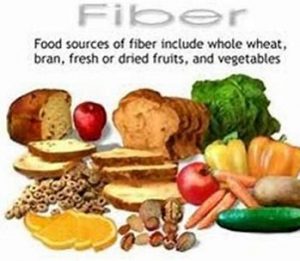 I grew up eating whole grain cereals for breakfast like Wheatena ( my favorite), a wonderful nutty and tasty hot treat with sliced banana and milk – those winter months in New Jersey were cold! Other cereals like Wheaties and Cheerios rounded out my whole grain intake…we didn’t know about whole wheat breads in my household. We ate Wonder Bread. Muffins and pancakes were made with Bisquick.
I grew up eating whole grain cereals for breakfast like Wheatena ( my favorite), a wonderful nutty and tasty hot treat with sliced banana and milk – those winter months in New Jersey were cold! Other cereals like Wheaties and Cheerios rounded out my whole grain intake…we didn’t know about whole wheat breads in my household. We ate Wonder Bread. Muffins and pancakes were made with Bisquick.
Years later I read about the benefits of fiber in my first nutrition book written by Adelle Davis titled “How to Eat Right and Keep Fit”. She explained the chemical bleaching process used to convert whole grains to white flour and warned of the dangers of eating flour devoid of nutrition, how it cannot be digested and just clogs the body as waste. It made me grateful to my mother for giving me whole grain cereals as a child.
Whole grains have been a staple in my diet since then and as I learned more about nutrition I added foods like fruits and vegetables to get additional fiber in my diet.
Here are some important facts to know about fiber and some examples of foods you can try for yourself and your family.
![]() Dietary Fiber
Dietary Fiber
Dietary fiber includes the parts of plant foods your body can’t digest or absorb..unlike other food components like fats, proteins and carbs which your body breaks down and does absorb. Fiber can’t be digested. It passes relatively intact through your stomach, small intestine and colon and out during elimination.
The Digestive System
There are 2 kinds of fiber:
- Soluable This kind dissolves in water, turning the food in the intestines into a gel from which nutrients can be absorbed at a slow, steady rate.
Examples of Soluable fiber are beans, oats, barley, bananas, potatoes, soft parts of apples and pears.
2. Insoluable This type promotes the movement through your digestive system and increases stool bulk. This kind of fiber is called “roughage” because it doesn’t dissolve in water. It holds on to water which helps to produce softer, bulkier stools helping to regulate bowl movements.
Examples of Insoluable fiber are whole bran, whole grain products, nuts, corn, carrots, grapes, berries, peels of apples and pears, and lettuce.
In addition to promoting healthy digestion, fiber provides us with these wonderful benefits:
*Fiber curbs overeating.. it’s filling without fattening”. These foods require more chewing and the prolonged chewing besides predigesting food satisfies the appetite so you eat less, it stays in the stomach longer, absorbs water and helps the eater feel full.
The best fibers for weight control are bran and the pectin from fruits.
![]() Here’s a tip worth its weight in gold…Eat high fiber foods with high fat foods to decrease the absorption of fat. Increase your daily fiber and you’ll absorb fewer calories.
Here’s a tip worth its weight in gold…Eat high fiber foods with high fat foods to decrease the absorption of fat. Increase your daily fiber and you’ll absorb fewer calories.
*Fiber steadies your blood sugar level, especially the soluable kind. It slows the absorption of sugar from the intestines. This steadies the blood sugar level and lessens the ups and downs of insulin secretion.
![]() A breakfast and lunch containing moderate amounts of soluable fiber can help a child who shows behavior and learning difficulties which may be caused by blood sugar swings.
A breakfast and lunch containing moderate amounts of soluable fiber can help a child who shows behavior and learning difficulties which may be caused by blood sugar swings.
* Keeping insulin levels low and stable helps store less fat.
*Fiber slows fat absorption by the body.
*Reduces cholesterol…A diet high in soluble fiber, such as that found in oat bran, whole oats, psyllium, legumes, barley, fruit, and prunes, lowers blood levels of the harmful type of cholesterol (LDL) without lowering the good cholesterol (HDL) levels. As it travels down the intestines, soluble fiber absorbs water and forms a gluey gel which picks up cholesterol and carries it out of the body.
*Promotes regularity – Insoluable fiber mainly from the cellulose in skins of fruits, vegetables and the husks of grains help prevent constipation, promotes peristalsis (the broom effect).
*While soluble fiber helps protect against cardiovascular diseases, insoluble fiber protects against colon cancer. It binds carcinogens (toxins that can transform normal cells into cancerous ones) lessening their contact with the intestinal wall. The water and bulk of the stools dilutes toxins reducing their potential to harm.
*Fiber promotes healthy intestinal bacteria and contributes to a friendlier intestinal environment.
For more information please visit these sources:
https://my.clevelandclinic.org/health/articles/14400-improving-your-health-with-fiber
http://3) http://extension.colostate.edu/docs/pubs/foodnut/09373.pdf
![]()
